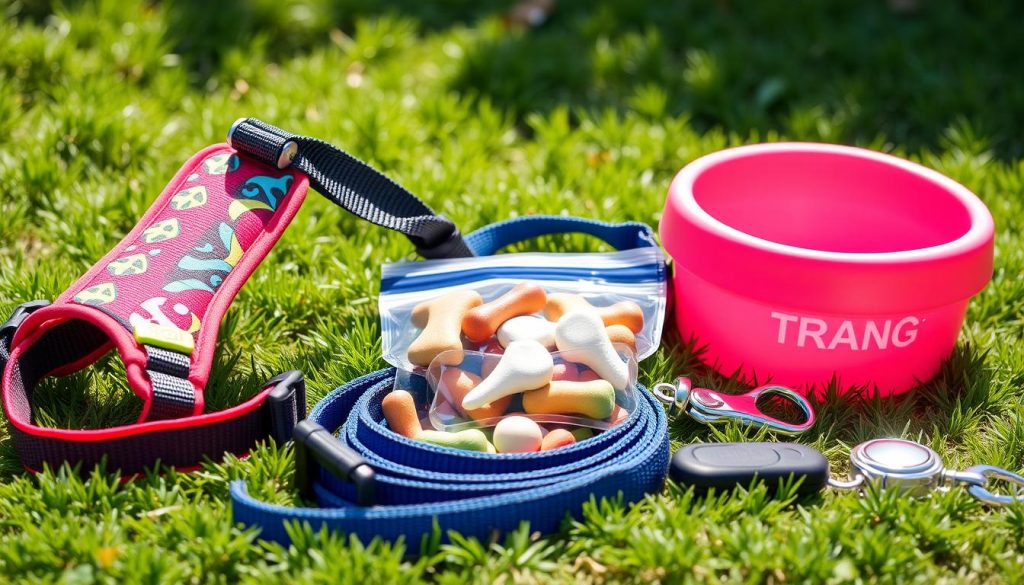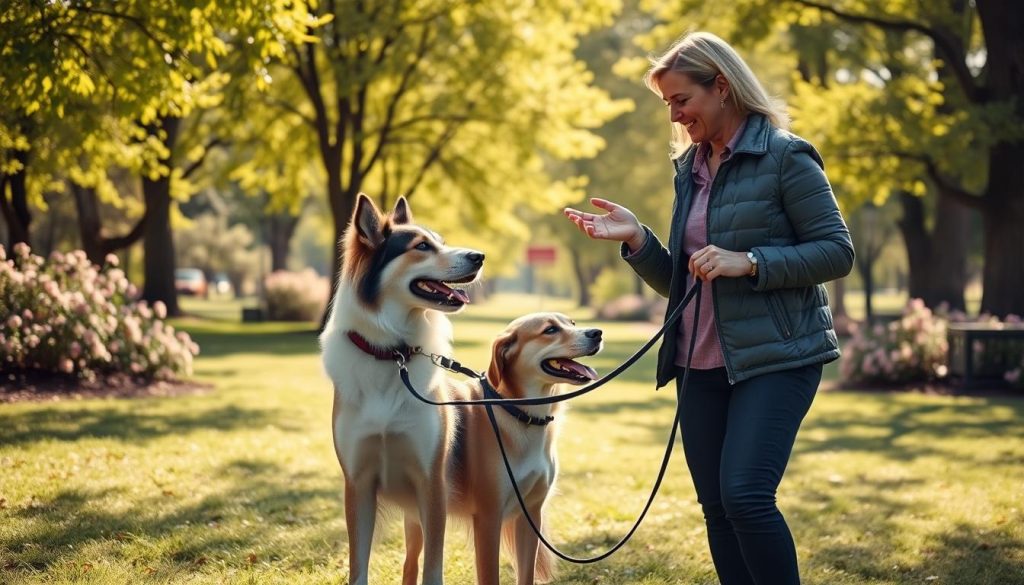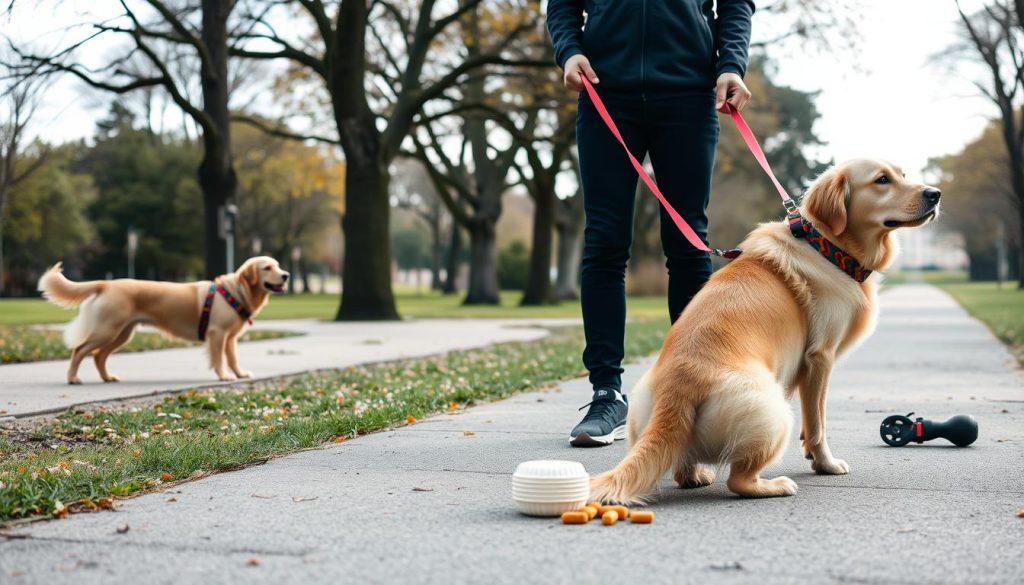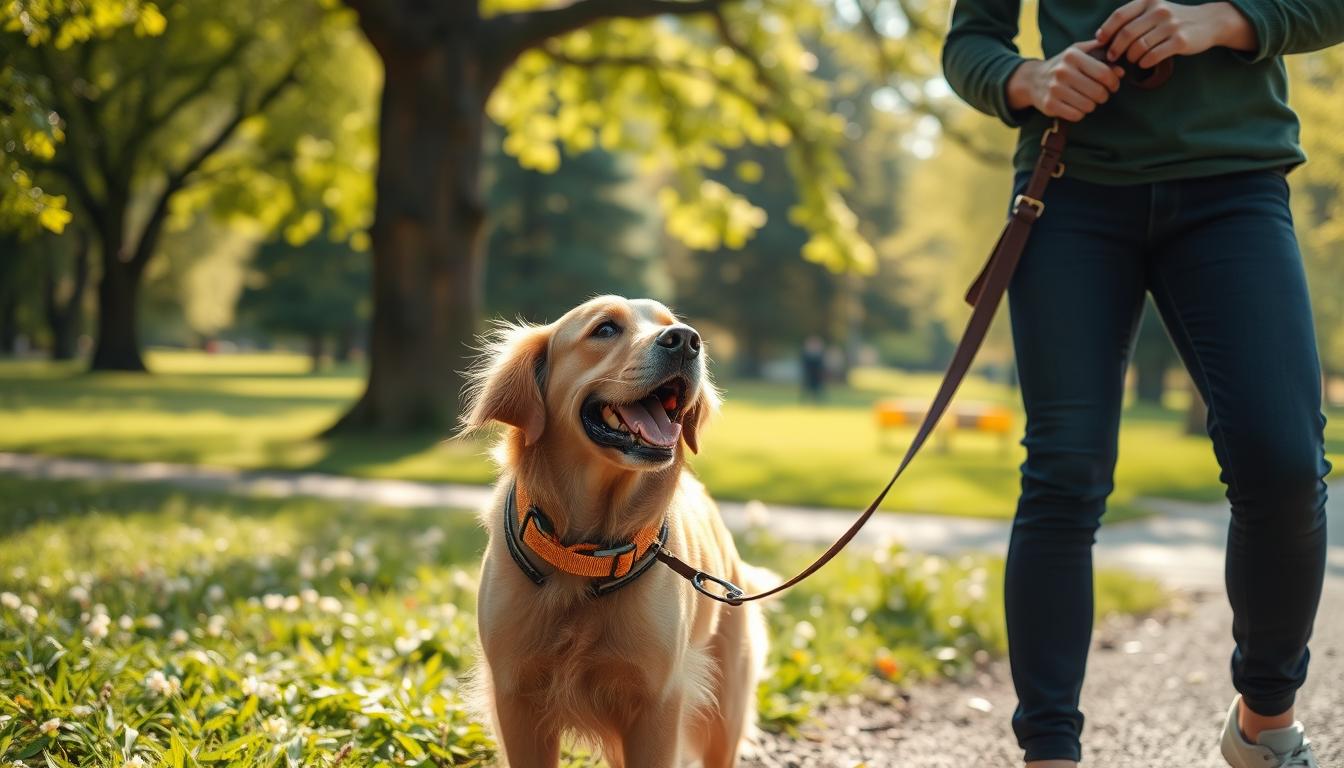As a devoted dog owner, I know how key it is to teach your dog leash manners. Whether your dog is a playful puppy or a grown-up, learning to walk on a leash can make walks fun and stress-free. In this guide, I’ll share my best methods for dog leash training. This will help you and your dog move through the world with confidence.
Teaching your dog to walk on a leash is more than just control. It’s about strengthening your bond, keeping everyone safe, and making sure your dog is happy. By teaching your dog to walk on a loose leash, you’ll enjoy calm walks, avoid problems, and build a disciplined relationship. Follow my advice, and you’ll be the talk of the town with your well-behaved, leash-trained dog.
The Importance of Leash Training for Dogs
Leash training is key for any dog owner. It keeps you and your dog safe. It also makes walks better by avoiding dog pulling on leash and other leash walking problems. We’ll look at the benefits of leash training and how to solve common issues.
Benefits of Proper Leash Manners
Walking your dog calmly on a leash is good for both of you. It makes walks fun and keeps you safe. Proper leash training can:
- Keep your dog out of danger, like busy roads or other animals
- Lower the chance of your dog pulling you and causing injuries
- Make your bond stronger by building trust and obedience
- Let you walk in crowded places with confidence, knowing your dog will listen
Addressing Common Leash-Walking Issues
Many owners struggle with leash walking problems like pulling or getting distracted. Knowing why these happen and using good training can solve these issues. We’ll share ways to fix common problems and make walks enjoyable for you and your dog.
Preparing for Leash Training Success

Before starting leash training, you need the right gear. Choosing the right dog leash, collar, or harness is key. Let’s look at the essential items for leash training success.
Essential Equipment and Supplies
Choosing the right dog leash training supplies can be tough. But, focusing on a few important items can make a big difference. Here’s what you need for a smooth leash training journey:
- A high-quality dog leash that fits your pup’s size and personality. Fixed-length leashes are better for training control.
- A comfy dog collar or dog harness for your dog. Harnesses are great for dogs who pull a lot.
- Positive reinforcement dog training equipment like treats and a clicker. These reward your dog’s good behavior.
- A strong yet light leash for control and freedom during walks.
Getting the best leashes for training and other supplies is crucial. It sets the stage for successful leash training and fun walks with your dog.
Establishing a Positive Mindset

Effective leash training starts with the right mindset. As you start this journey with your dog, it’s key to be positive and patient. This way, you’ll build a stronger bond and make training fun for both of you.
Positive reinforcement is key to leash training success. It rewards your dog for good behavior, not punishing for bad. When your dog does well, praise them and give treats or toys. This makes them want to please you more.
Keeping calm and confident is also important. Dogs pick up on our feelings. If you’re frustrated, it can make them less willing to learn. So, go into each session with a smile and patience, knowing it’s a journey.
Your dog’s mindset is shaped by yours. A positive outlook makes them feel safe and motivated. Enjoying walks together will strengthen your bond and make your lives better.
| Positive Reinforcement Techniques | Mindset for Successful Leash Training |
|---|---|
|
|
Dog Leash Training: Step-by-Step Guide

Learning leash training is key for your dog’s safety and your fun walks together. I’ll guide you through a simple process. It will teach your dog the “heel” command and keep them focused, even with distractions.
Teaching the “Heel” Command
The “heel” command is the base of leash training. It teaches your dog to walk beside you calmly. Start by attaching the leash to your dog’s collar and standing still. Give your dog a treat each time they stay close and walk at your pace.
Slowly increase the distance and time of these sessions. Always reward good behavior.
Managing Distractions and Reinforcing Focus
- Find out what might distract your dog, like other dogs, wildlife, or smells.
- Practice the “heel” command in these situations. Use treats to reward them for staying focused on you.
- If your dog gets too distracted, gently move them away. Then, practice in a quieter place.
- Always praise and reward your dog for good behavior during walks. This will improve their leash skills.
By following this guide and practicing regularly, you’ll teach your dog the “heel” command. They’ll stay focused during walks, making your time together safer and more fun.
Mastering Dog Leash Training
As you work on leash training, you might hit some bumps. But don’t worry, I’ve got top tips to help you get past common hurdles. This way, you and your dog will master walking together without a leash.
Troubleshooting Common Challenges
One big issue is when dogs pull on the leash. It’s annoying, but you can teach them to walk nicely beside you. Start by practicing the “heel” command in a quiet place. Give your dog treats and praise when they walk without pulling.
Dealing with distractions like squirrels or other dogs can also be tough. To handle this, give treats and praise when your dog stays focused on you. Make training fun and positive, even when things get busy.
| Common Challenge | Expert Tip |
|---|---|
| Pulling on the Leash | Practice the “heel” command in a distraction-free environment, rewarding loose-leash walking. |
| Distractions | Use intermittent treats and praise to reinforce focus, gradually increasing the level of distraction. |
Remember, being consistent and patient is crucial in leash training. By tackling these overcoming leash training challenges directly, you and your dog will soon be expert leash walking tips.
Dog Leash Training in Various Environments
Teaching your dog to walk on a leash is just the start. The real challenge comes when you’re out in the world. There, distractions and new places can test even the best-trained dogs. But don’t worry – with the right steps and flexible methods, your dog can stay well-behaved in many places.
Whether you’re walking in a busy city or a quiet nature trail, the goal is to introduce your dog to new things slowly. Begin in quiet spots, then add more distractions as your dog gets more confident. This way, your dog will learn to stay calm and focused, even with interesting smells, people passing by, or animals watching.
- Find common distractions like traffic, other animals, or crowds in your area. Then, add them to your training sessions.
- Practice the “heel” command in different places. Reward your dog for walking close to you without pulling.
- Get your dog used to things like buses, elevators, and other new experiences. This will help them get ready for outings.
When training in different places, always be patient, positive, and consistent. With time and effort, your dog will walk calmly and confidently with you, wherever you go.
Being flexible with your training is crucial for your dog’s good leash behavior in any setting. By listening to your dog’s needs and being proactive and adaptable, you’ll help them feel confident and graceful in the world.
Maintaining Consistent Dog Leash Training
Leash training is a continuous effort. It’s essential to keep it up to ensure your dog’s good habits stick around forever. By consistently reinforcing your dog’s leash manners, you can prevent them from slipping back. This makes walks enjoyable for both you and your dog for many years.
Reinforcing Good Habits
Being consistent is the key to successful leash training. Even after your dog has learned the basics, keep practicing the “heel” command. Reward your dog for walking calmly by your side. Regularly doing training exercises helps keep those good habits strong.
Make leash training a part of your daily routine. It could be a quick practice before going out or a structured training walk. This keeps your dog focused and engaged. It ensures those polite leash manners become a natural part of their behavior.

